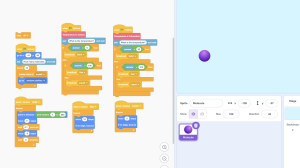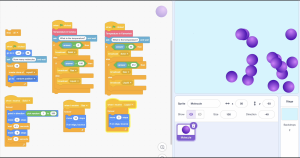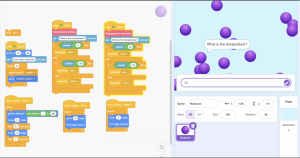70 Chapter 58: Simulating Molecular Motion in Different States of Matter
By: Preetika Gandhi
Simulating Molecular Motion in Different States of Matter
Description
This lesson uses Scratch to simulate how water molecules behave in solids, liquids, and gases based on temperature. Students will input a temperature in Celsius, and the program will adjust the molecular motion accordingly to reflect particle movement in different states of matter.
Introduction
Imagine you are holding an ice cube in your hand. As it warms up, it starts to melt, and eventually, if you heat it enough, it turns into steam. But have you ever wondered what is happening to the water molecules inside? In this lesson, we will use Scratch to simulate how water molecules behave at different temperatures. By coding their movements, you will see how solids vibrate, liquids flow, and gases spread out—just like in real life! Get ready to bring molecular motion to life through coding!
Working On It
- Students will access the Scratch project and input the temperature of the water molecules.
- Based on the input, the program will determine whether the state of matter is solid, liquid, or gas.
- Students will observe how the molecules move differently in each state—vibrating slightly in solids, moving freely in liquids, and spreading out rapidly in gases.
- Students will analyze how the code works, including the use of variables, conditionals, and loops.
- They will modify the project to explore additional behaviours, such as changes in molecule colour or speed based on temperature.


Key Questions Could be Explored in This Project:
Q1. In this Scratch project, the water molecules move the same way at 1°C and 99°C. However, in real life, their speed changes as temperature increases. Can you program the water molecules to behave correctly based on temperature?
Q2. How would aluminum molecules appear, and how would they behave at different temperatures? Can you create a simulation to demonstrate this?

Consolidation
Students will reflect on how coding can enhance scientific understanding. They will discuss the accuracy of the simulation and brainstorm ways to improve it, such as adding phase change animations or introducing a cooling/heating function over time. The lesson concludes with a class discussion on the importance of simulations in science.
Resource information
Tags: Science: Science, Coding, Molecular Motion, Scratch, Simulation
Main Subject: Science
Other integrated subjects: Coding
Learning to code: Yes
Coding to learn: Yes
URL link to code: https://scratch.mit.edu/projects/1140741273
Media Attributions
- Codes
- Liquid State
- What is the temperature_
